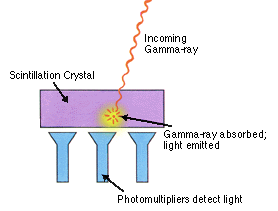Gamma-ray Detectors
How Do You Detect a Gamma-Ray?
Gamma-rays, like visible light, are made up of packets of energy called
photons. However, in the case of gamma-rays, the photons have millions
of times more energy than in visible light. Gamma-rays are detected by
observing the effects they have on matter. A gamma-ray can do a few basic
things inside matter. It can collide with an electron and bounce off it like a
billiard ball (Compton scatter) or it can push an electron to a higher energy
level (photoelectric ionization). Also since gamma-rays have so much energy,
part of this energy can be transformed into matter directly by creating an
electron and another particle called a positron (pair production).
All of these interactions cause electrons to move in some way, which
basically means that an electric current has been created. These
currents can then be amplified and measured to estimate the energy and
direction original gamma-ray.
|

|
Can You Focus Gamma-Rays?
Visible light can be focused by using mirrors or lenses to
bend the paths of the photons and concentrate them in one place. This
creates a sharper, brighter image. Mirrors and lenses don't work with
gamma-rays very well. When a gamma-ray hits matter (like in a mirror or
lens), it will interact with the material in such a way as to destroy the
gamma-ray or change its energy by a large amount. Focusing means to bend
the photon's path without changing its energy too much, and that is not
easy to do with gamma-rays. This means that images we have from the
gamma-ray region are not as sharp (that is, they have poorer
angular resolution) than images taken in the visible or most other
wavelengths.
Sources of cosmic gamma-rays are extremely weak (that is, they produce
relatively few gamma-ray photons for us to detect in the vicinity of
Earth) and require long observations, sometimes several
weeks, to get a significant detection or accurate measurement of a
source. Focusing helps to
increase our ability to detect the "signal" from the cosmic source.
Basic Types of Gamma-ray Detectors

Diagram of a
Compton Scatter Telescope |
Gamma-ray detectors can be placed in two broad classes. The first are
what would typically be called spectrometers or photometers in optical
astronomy. These are instruments which are "light buckets" and focus on
a region of the sky containing the object of interest collecting as many
photons as possible. These types of detectors typically use scintillators
or solid-state detectors to transform the gamma-ray into optical or
electronic signals which are then recorded. The second class are
detectors which perform the difficult task of gamma-ray imaging. Detectors of
this type either rely on the nature of the gamma-ray interaction process
such as pair production or Compton scattering to calculate the arrival
direction of the incoming photon, or use a device such as a coded-mask
to allow an image to be reconstructed.
So you may ask, "Why look at gamma-rays?". The answer is that some
very important events in the Universe, like supernova or matter falling
into black holes, radiate large amounts of energy in the gamma region. In
addition, gamma-ray detectors have revealed completely new discoveries like
gamma-ray bursts. Simply put, without gamma-ray detectors some important
questions about our Universe just could not be answered.
|
|
